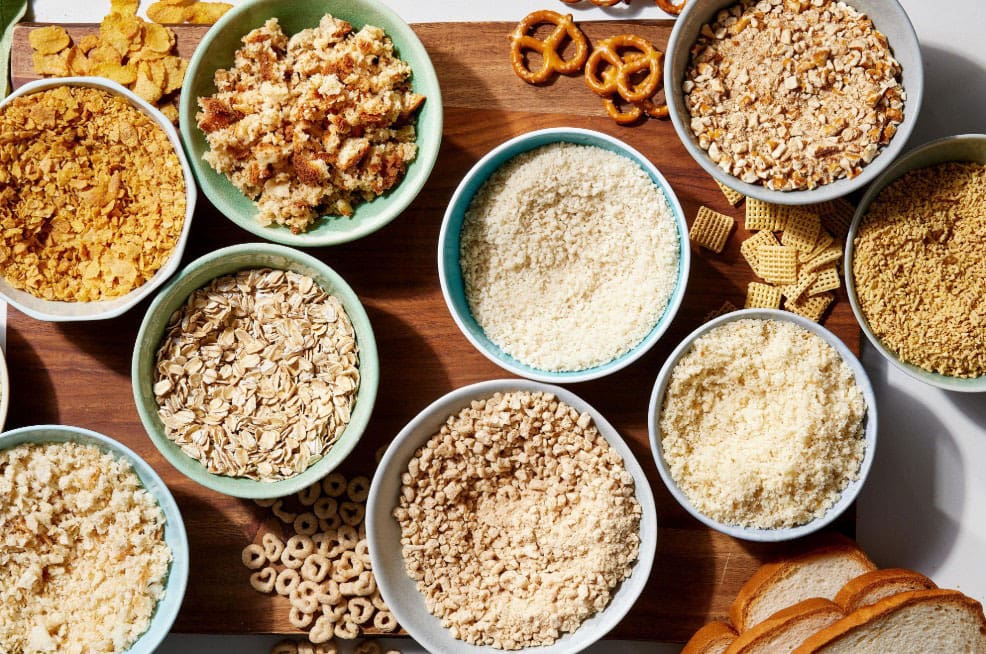Bread Crumbs: Tips for Cooking and Substitutes
When you don’t have breadcrumbs or want to try something else, what are healthy substitutes for breadcrumbs that may yield similar results without sacrificing flavor or texture?

Bread Crumbs
Various recipes call for bread crumbs. Adding bread crumbs to sauces and other dishes helps bind and thicken wet ingredients while sprinkling bread crumbs on top of casseroles can add a crispy, crunchy texture. Individuals who follow low-carb or gluten-free meal plans or those with allergies to wheat may choose to avoid bread crumbs and dishes made with them. Wheat-free substitutes can replace bread crumbs in recipes with similar results, though the recipe may vary slightly.
Why Use Substitutes?
Individuals with food allergies or dietary restrictions may seek a substitute for bread crumbs since they may contain common allergens like wheat and gluten. Wheat is among the most common food allergies in the U.S. (Asthma and Allergy Foundation of America, 2022)
For those with allergies or sensitivities, gluten- and wheat-free bread crumbs are available to purchase at some stores, and some use alternatives out of preference. Crushing different varieties of chips, crackers, and pretzels can be used instead of bread crumbs, adding a unique flavor and texture. However, these substitutes may not be an option for recipes that call for bread crumbs to bind or thicken wet ingredients.
Nutrition
Nutrition information for 1 ounce (28.35 grams) of unseasoned bread crumbs. (USDA, FoodData Central, 2018)
- Calories – 112
- Fat – 1.5 grams
- Sodium – 208 milligrams
- Carbohydrates – 20.4 grams
- Fiber – 1.28 grams
- Sugars – 1.76 grams
- Protein – 3.8 grams
Bread products like bread crumbs can be part of a balanced diet. Guidelines recommend between 3 and 5 servings of whole grains daily for adults, including whole-wheat bread. (United States Department of Agriculture, 2025)
- The main macronutrient in bread crumbs is carbohydrates.
- Bread crumbs are usually consumed in small amounts because they are not the main ingredient.
Substitutes
Rolled Oats or Oat Flour
Oats and oat flour are often used as gluten-free alternatives to wheat in baking. Oats by weight are:
- Lower in calories
- Provide more complex carbohydrates.
- They are a richer source of dietary fiber than bread crumbs.
Like regular flour, oats can be a binder in meat-based recipes. For example, if a recipe for meatloaf or meatballs calls for bread crumbs, rolled oats or oat flour can be successfully substituted.
Ensure the oats are gluten-free for individuals with gluten allergies, celiac, or gluten sensitivity. Though oats are inherently gluten-free, they may be processed on shared equipment and exposed to cross-contamination.
Cornflakes
- Cornflakes can also add a crunchy texture to baked recipes. While corn is inherently gluten-free, cornflakes may not be. For individuals who have allergies or sensitivities, ensure you use gluten-free cornflakes. To use cornflakes, crunch them up by adding them to a ziplock bag and pressing them on the outside.
Nuts
- Try nuts like almonds, walnuts, pecans, and cashews to add crunch and nutrients to a recipe. They are rich in healthy fats, protein, vitamins, and minerals. Plain nuts are also gluten-free, but roasted nuts may contain a wheat-based coating. Be sure to read the labels before using them.
Seeds
- Seeds are a nutritious substitute.
- They offer a different crispy, crunchy texture.
Shredded Coconut
Shredded or desiccated coconut can be used for sweet or rich recipes. It is perfect for adding to baked goods, especially gluten-free varieties. The recipe may need to be adjusted slightly because coconut has more moisture than regular bread crumbs. Do a small sample first to see how the coconut works in the recipe.
Injury Medical Chiropractic & Functional Medicine Clinic
Injury Medical Chiropractic and Functional Medicine Clinic works with primary healthcare providers and specialists to develop highly effective treatment plans through an integrated approach for each patient and restore health and function to the body through nutrition and wellness, functional medicine, acupuncture, electroacupuncture, and integrated medicine protocols. We focus on what works for you to relieve pain, restore function, prevent injury, and mitigate issues through adjustments that help the body realign itself. The clinic can also work with other medical professionals to integrate a treatment plan to resolve musculoskeletal problems.
Hypertension? There’s a Diet for That
References
Asthma and Allergy Foundation of America. (2022). Food allergies. https://aafa.org/allergies/types-of-allergies/food-allergies/
United States Department of Agriculture, FoodData Central. (2018). Bread crumbs, dry, grated, plain. Retrieved from https://fdc.nal.usda.gov/food-details/174928/nutrients
United States Department of Agriculture. Dietary Guidelines for Americans 2020-2025. (2020). Dietary Guidelines for Americans, 2020-2025. Retrieved from https://www.dietaryguidelines.gov/sites/default/files/2021-03/Dietary_Guidelines_for_Americans-2020-2025.pdf

